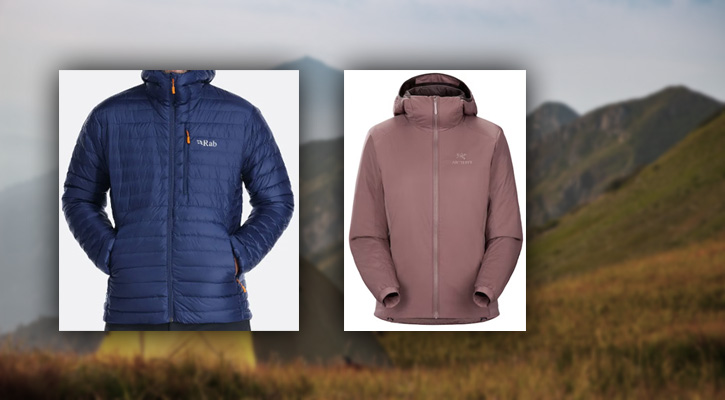
When it comes to outdoor gear, the debate about which brand to choose can be as challenging as the terrain you’re planning to conquer. Two titans in the world of alpine jackets, backpacks, and climbing equipment are RAB and Arc’teryx.
Both have rich histories and a commitment to quality that has garnered them loyal followings in the outdoor community all over the world. But which is better?
RAB, with its humble beginnings in the hands of a Scottish mountaineer, has evolved into a brand with a deep understanding of what climbers need.
On the other hand, Arc’teryx, born from the rugged landscapes of Canada and named after a creature symbolizing evolution, offers premium materials and cutting-edge designs.
In this comparison, we’ll look at their materials, construction, and the important balance between performance and price.
So, join us as we explore the strengths of these two companies and help you make the right decision for your next adventure!
Contents:
1. RAB Outdoor Gear
History of the Brand
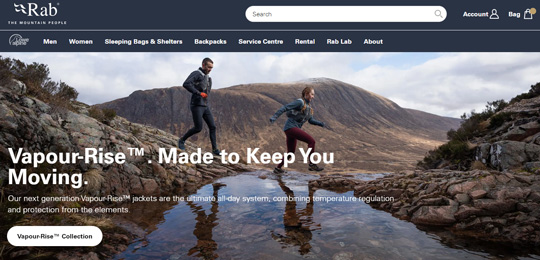
RAB official website
RAB‘s origins can be traced back to 1981, when Rab Carrington, a Scottish mountaineer, established the company in Sheffield, South Yorkshire, England, using his name. Having a passion for nature, climbing, and adventure, Rab Carrington gained recognition as an accomplished climber among his peers.
During a UK strike in 1973, he found himself stranded in Buenos Aires without equipment, leading him to learn how to craft high-quality sleeping bags with the guidance of his friend, Hector Vieytes. This experience motivated Rab Carrington to create the brand RAB.
The company prides itself on being “by climbers for climbers” and has introduced several products that have become iconic in the mountaineering and climbing communities.
In 2001, Rab partnered with Polartec, whose materials are still utilized in Rab gear today.
Since 2003, Equip Outdoor Technologies Ltd has owned Rab, upholding the brand’s ethos and designing renowned jackets like the Microlight Alpine, solidifying the brand’s reputation as one of Europe’s leading providers of specialized outdoor apparel.
Don’t miss:
7 Brands like RAB for Outdoor Adventures
8 British Outdoor Clothing Brands that You’ll Love
Materials, Fabrics, and Production Process
Every year, Rab demonstrates a strong commitment to eco-friendly production methods, including ethical material sourcing, PFC-free water-repellent treatments, and the use of recycled materials to create long-lasting products.
The brand predominantly utilizes polyester and nylon. Waterproof outerwear is crucial for winter, and Rab employs various fabric technologies, such as Gore-Tex and Pertex Shield, to ensure protection from the elements. These technologies differ in breathability, wind resistance, and overall performance.
Rab’s waterproof fabrics are available in 2, 2.5, and 3-layer constructions, tailored for specific uses. For breathability, the brand utilizes Hydrophilic and Microporous technologies for moisture-wicking.
For insulation, Rab offers a range of natural down and synthetic insulation in jackets and sleeping bags, with a focus on responsible sourcing and the use of 100% recycled fabrics and down insulation.
Synthetic insulation, including Stratus, Cirrus, Pyrotec, and PrimaLoft is also prominently featured in Rab’s products, mainly in sleeping bags, jackets, and gloves.
The video will be loaded from YouTube.com, a third party. If you play it, you accept their terms of service, and their use of cookies.
Read also:
Norrøna vs RAB Outdoor Gear: Which is Better?
RAB vs Patagonia Outdoor Equipment: A Comparison
Where is RAB outdoor gear made?
Rab’s items are produced partially in the UK, where the company is headquartered, and the rest in Asia, predominantly in China.
Recommended Products
RAB Men’s Microlight Alpine Down Jacket
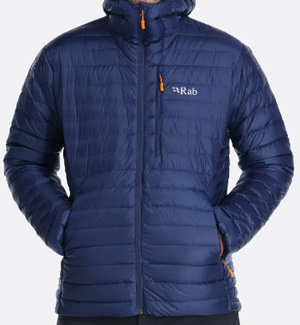
Image: rab.equipment
Check it out at rab.equipment
The Microlight Alpine represents a lightweight winter jacket featuring 700 fill-power hydrophobic down insulation, offering warmth and water resistance in wet conditions. Constructed with Pertex Quantum technology, the shell ensures durability against the elements and provides breathability, catering to various activities.
This jacket includes two hand pockets and a chest pocket on the exterior, with the former being harness-compatible. Available in men’s and women’s sizes, the Microlight Alpine is highly compressible for convenient transportation.
RAB Aeon 35L Daypack
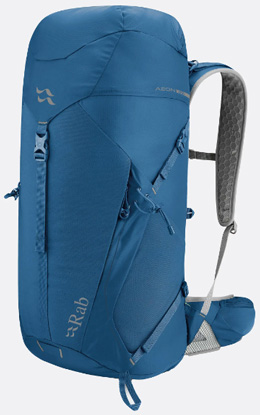
Image: rab.equipment
Check it out at rab.equipment
The RAB Aeon 35L Daypack proves to be a versatile backpack suited for a range of mountain excursions. Featuring the Air Contour X carry system, it offers a secure fit and the ability to sustain substantial loads while ensuring stability on rugged paths.
Its semi-rigid back panel facilitates air circulation and conforms to the user’s physique. The encompassing stretch yoke provides a comfortable fit across the shoulders, while the adjustable back length and forward pull hip belt enable a customized experience.
With a 35-liter capacity, it is well-suited for camping and hiking and includes practical features such as walking pole attachments, a walking axe loop, and easily accessible pockets for gear storage.
The zippered hip belt pockets offer convenient storage for small essentials, and the daypack is crafted from 50% recycled nylon fabric, accompanied by a protective rain cover for all-weather usage.
Prices
RAB in general falls in the mid-to-high category when it comes to prices. The range of the brand’s jackets starts at $80 (for windbreakers and similar styles) and reaches up to $850 (for down jackets and technical designs).
The price of the backpacks ranges from about $60 to $250, depending on the specific design, and the prices of other gear and accessories vary significantly.
Are RAB products worth the price?
The response varies depending on your product expectations. But in general, RAB has a great reputation for creating durable, top-notch designs. So, we think the answer is Yes!
Learn more: Why is RAB so Expensive? Is It Worth It?
2. Arc’teryx Outdoor Gear
History of the Brand
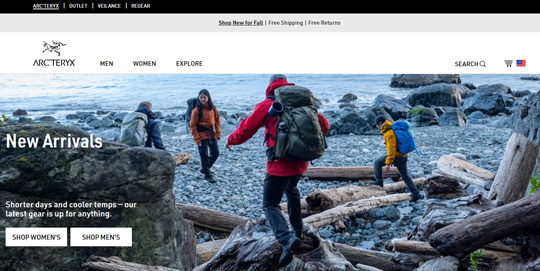
Arc’teryx official website
Established in 1989 by Dave Lane, Arc’teryx is a renowned Canadian brand that specializes in outdoor apparel and equipment. Originally known as Rock Solid, the company initially concentrated on manufacturing climbing gear.
In 1991, Dave Lane joined forces with Blair Murdoch and Tim Duholke, leading to the adoption of the official name Arc’teryx. The brand’s name is inspired by the Archaeopteryx, the earliest known bird, representing progress and originality.
Arc’teryx has introduced several notable products, such as the pioneering early versions of the Bora backpack and the Vapor harness. Upon obtaining the rights to utilize Gore-Tex fabrics, the company broadened its product line to encompass outdoor clothing, with many of its top-performing pieces still incorporating Gore-Tex fabrics.
While the brand initially focused on climbing gear, it now serves hikers, climbers, and snowsport enthusiasts, offering some of the finest snowsport clothing on the market.
Don’t miss:
9 Outdoor Brands like Arc’teryx: Our Favorites
Mammut vs Arc’teryx Outdoor Gear: A Comparison
Materials, Fabrics, and Production Process
Arc’teryx is well-known for its use of premium, sustainable, and responsibly procured materials. These materials hold Bluesign® certification and undergo thorough evaluation via the Life Cycle Assessment protocols to gauge the impact of the product life stages.
The brand employs a mix of natural and synthetic materials, tailored to each design, to guarantee the superior quality of all final products. The insulation utilized in jackets adheres to the Responsible Down Standard, ensuring the ethical treatment of ducks and geese.
Coreloft is predominantly used for synthetic insulation blends, while Gore-Tex is the go-to for membranes and fabric technologies in the brand’s clothing line.
In the realm of backpacks, Arc’teryx implements its proprietary AC2 technology. The company places a strong emphasis on ethical manufacturing and material sourcing, factors that have significantly bolstered its standing and appeal over time.
The video will be loaded from YouTube.com, a third party. If you play it, you accept their terms of service, and their use of cookies.
Read also:
Is Arc’teryx Sustainable? A Look at their Environmental Practices
Jack Wolfskin vs Arc’teryx: Which Brand is Better?
Where is Arc’teryx outdoor gear made?
Arc’teryx makes its outdoor gear in various countries, including Canada. The Canadian facility, ARC’One, is based in Vancouver, BC, producing 10% of the brand’s equipment.
The majority of Arc’teryx products (90%) are made in Asian countries like China, Vietnam, Bangladesh, Indonesia, Philippines, etc., but also in Romania and El Salvador. (source)
Recommended Products
Arc’teryx Atom Women’s Hoody
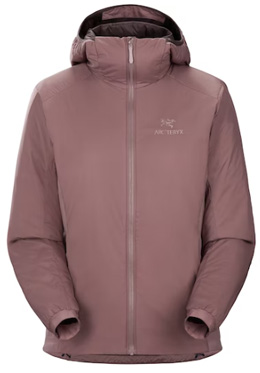
Image: arcteryx.com
Check it out at Arcteryx.com
The Women’s Atom Hoody is a lightweight and practical jacket equipped with synthetic insulation, suitable for use as either a mid-layer or standalone, depending on the conditions.
It belongs to the Atom Series, incorporates Coreloft Compact insulation, and is available in multiple colors and sizes. This garment is engineered for high performance and represents an outstanding option for outdoor enthusiasts in search of resilient and adaptable equipment for pursuits like trekking, climbing, or backpacking.
Arc’teryx Bora 65 Backpack for Men
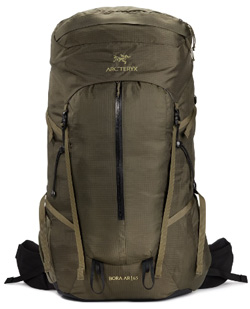
Image: arcteryx.com
Check it out at Arcteryx.com
The Arc’teryx Bora 65 Men’s Backpack offers a great choice for outdoor lovers preparing for a weekend or week-long adventure. It provides a comfortable carry that allows you to explore new areas and challenge your boundaries. The RotoGlide™ hipbelt moves in sync with your body, improving balance and extra stability.
Crafted from high-strength Cordura® pack cloth, the backpack is resilient for wilderness use. The top lid includes a Weather Vault for waterproof storage, and the main compartment is easily accessible from the top or side, along with multiple external pockets.
This backpack is a dependable and long-lasting choice for outdoor enthusiasts in search of a comfortable and practical option for extended wilderness journeys.
Prices
Arc’teryx is a premium brand considered very expensive in the outdoor community, offering jackets priced from $150 to $1000 and backpacks ranging from $50 to $350.
Are Arc’teryx products worth the price?
Despite the premium costs, Arc’teryx items justify the initial cost due to their outstanding performance and long lifespan, in our opinion.
Arc’teryx equipment is worth its price for individuals dedicated to advanced mountain pursuits or winter sports. Although the prices may create a barrier for certain customers, the excellence and resilience of the gear justify the investment.
Learn more: Why is Arc’teryx so Expensive and Popular? Is It Worth It?
3. Which is Better? RAB or Arc’teryx?
Both are great and it’s not very easy to say one is better than the other. But if we had to choose, we’d consider the factors below.
RAB Strengths:
- More affordable pricing;
- Specialized expertise in insulation (natural down and synthetic);
- Use of recycled materials;
- Slightly higher scores for durability and weight.
Arc’teryx Strengths:
- Premium materials;
- Meticulous design and construction;
- More features and functionality, sustainable practices;
- Edge in waterproofing and breathability.
In the end, for the budget-conscious buyer who prioritizes insulation and sustainability, RAB offers great performance and value.
If you prefer to pay more for cutting-edge materials, impeccable craftsmanship, and maximum features, Arc’teryx is hard to beat.
The ideal choice comes down to your needs and preferences. For example, if you’re an alpinist wanting a summit-ready hardshell, you may prefer Arc’teryx. If you’re a backpacker looking for reliable, highly-packable synthetic insulation at a reasonable cost, you may prefer RAB.
But in general, both make great gear, so you can’t go wrong with either for serious outdoor activities.
Read next: 9 High-End, Expensive Hiking Brands for Clothing and Footwear
